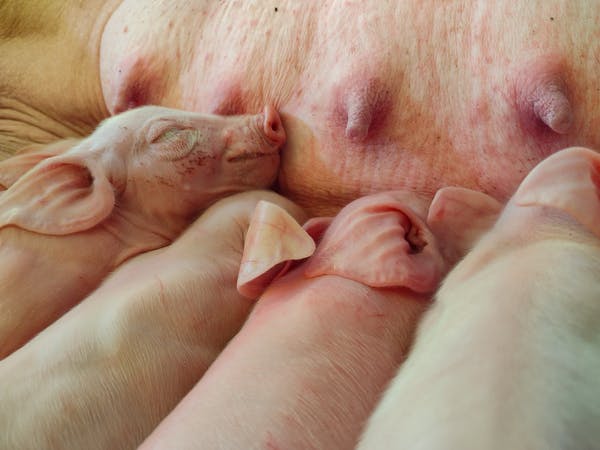This is an agricultural website, so we’ll be looking at colostrum in farm animals and not humans.
Colostrum is very important in the life of every young animal, from calves to puppies to kids to lambs to piglets to kits to kittens and the likes. It is the first milk produced from the mammary glands of all mammals. This milk should be given timely and on time as it helps every young with needed nutrients for proper growth and body functioning.

What is colostrum?
Colostrum is the initial milk produced in the mammary gland, following the birth of an offspring. It is different from whole milk because it contains some good amount of immunoglobulins which is also known as antibodies. It is a vital source of growth factors and nutritional elements such as protein, fat, milk sugar, vitamins and minerals.
Even though all mammals produce it, supplements are usually made from the colostrum of cows. This supplement is known as bovine colostrum which is kind of similar to that of humans, rich in vitamins, minerals, fats, carbohydrates, disease-fighting proteins, growth hormones, and digestive enzymes.
Bovine colostrum is not of much importance when dams can breast feed their young. We’ll look at some circumstances of needing bovine colostrum later during this read.
It must be given to every young animal few hours after birth. IgG absorption is most efficient in the first 4 hours of life and declines rapidly after 12 hours of age.
At 24 hours, the gut is completely closed and there is no immunoglobulin absorption into the circulation after that time. These absorbed antibodies must be consumed in order to protect the calf from disease organisms until its own immune system becomes functional.
In agriculture, there’s something called failure of passive transfer (FPT). This occurs when a young animal fails to absorb an adequate quantity and quality of immunoglobulin. For calves, they are defined as having failure of passive transfer if the calf serum IgG concentration is less than 10mg/ml.
Lack of the right amount and quality milk have been linked with young animal’s morbidity, mortality and a reduction in growth rate. Hence this first milk just have to be in the picture.
What’s the color of colostrum?
The highly concentrated and nutritious first milk from every mammal immediately after birth is often thick and yellowish in color. It gradually turns to cream and white (whole milk) after 24hours of birth.
The importance of colostrum to newborns
The first milk produced by the dam after birth, is high in nutrients and antibodies. A newborn lacks disease protection because antibodies do not pass across the dam’s placenta to the fetus’ circulatory system. Antibodies in colostrum provide newborn animals with their initial protection.
The importance of colostrum to newborn farm animals include;
-
- It provide antibodies, the absorbed antibodies protect against systemic invasion by pathogens while antibodies that are not absorbed play an important role in protection against intestinal diseases.
- It helps fight against early mortality and morbidity in animals.
- It washes the entire system of young animals and prepare them for whole milks.
- This milk helps to aid easy digestion in young animals.
- It has a laxative effect that helps newly born animals clear meconium and lessens the chance of jaundice.
- Helps to strengthen the immune system of the young animal.
Read also: Cattle by products
When is the best time to give colostrum?
It must be given to young animals immediately after birth. It is most efficient during the first 4hours of life. immunoglobulin content starts to rapidly decline after 12hours, and completely dries up after 24hours. This isn’t so for every farm animal as some produce more colostrum than others.
In general, to avoid newborns from not getting colostrum, it should be given within the first 4 hours of every animal life.
Failure to do so can lead to sickness, decrease in weight and even death of the young animal.
What is the adequate amount to be given?
Colostrum is very important because of what it contains. Given its importance, an adequate amount should be given to farm animals.
Inadequate amount of colostrum can lead to improper functioning of the newborn’s system and too much of colostrum can lead to diarrhea or milk scouring in young animals.
To prevent any of these from happening, newly born needs the amount of colostrum that matches at least 5% of their body weight within the first 4 hours of birth and 10% within the first 12hours of birth for proper body functioning.
The weight of every new born is always taken immediately after birth. So plus 10% of their initial weight is what is required for an adequate colostrum amount for proper body functioning. Not less and not more.
When dams are unable to feed their young
Dams may be unable to feed their young with colostrum due to the following reasons;
- Stress due to prolonged labor.
- Death of the dam
- Dams not milking enough colostrum
In a case of stress due to prolonged labor, colostrum can be gotten and given to the young animal by milking the dam. This can be done by simply using your clean hands or an extractor on the udder to get the first milk, or you simply take from already stored bovine colostrum and give to the newly born.
In the case of death of a dam, a bovine colostrum can be used or you simply introduce the young animal to a foster dam. When dams are not milking enough colostrum, they can be helped with a milk extractor to fasten the process or you simply use a bovine colostrum.
Read also: Difference between alpaca and llama
Side effects
Colostrum provides antibodies which is very needed by the newly born. Its only side effect is when it is given in a very large quantity, that is more than 10% of the animal body weight within the first few hours of birth. This can lead to diarrhea and even the death of the young mammal if not properly handled.
Your scale can help with the monitoring of this.
How to store colostrum
Colostrum that is not fed within 2 hours of collection should be refrigerated to control bacterial growth. Refrigeration at 4ºC in plastic containers maintains the viability of antibodies and other components of colostrum for up to 7 days.
For long term preservation, colostrum can be frozen for up to one year with little nutrient loss. The best method for storing colostrum in the freezer is in 2 liter stackable, plastic containers or freezer bags.
Read also: Breeds of cattle
The bottom line
colostrum is the first milk given to newly born mammals which contains immunoglobulins or antibodies. this milk should be given on time to prevent diseases and sometimes death of the young.
It prepares the animal for whole milk and in cases where dams can’t feed their newly born, artificial help should be given to make sure the young animal gets the right amount needed for proper body functioning.
the right amount to be given is 10% of the total body weight of the animal.
PLEASE SHARE⇒
